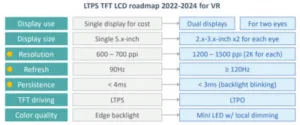Yesterday, I introduced AR and its applications and today I’ll look some other aspects of AR and VR. The VR/AR category was expanded to include “MR” (Mixed Reality) also called “MX” (or passthrough AR – editor). It is differentiated from the other two by replacing optical see-through with video see-through which has lower luminance requirements than AR. The next figure shows the three categories, the display technology used and some sample products.

 Figure 3: AR/VR/MR Products vs. Performance Categories. Source:Omdia
Figure 3: AR/VR/MR Products vs. Performance Categories. Source:Omdia
LTPS TFT LCDs are mature technology but create form factor issue in terms of size and thickness. OLED on Silicon (OLEDoS) interest is surging but the suppliers have limited production resources, even for Sony and Epson. TFT OLEDs have limited resolution due to the FMM, which cannot get beyond 1,000 ppi. New approaches, such as laser and lithographic patterning are under development. The next figure shows the display adoption characteristics.
 Figure 4: LTPS LCD VR Specifications and Optics. Source: Omdia
Figure 4: LTPS LCD VR Specifications and Optics. Source: Omdia
As the performance requirements for each category are better understood, there is an expectation that direct view displays (TFT) will be replaced by si-based near-to-eye solutions, which have higher pixel density, higher luminance and a smaller form factor. But other than Sony and Epson, microdisplay makers are quite small with less than 200 employees. In the US, only eMagin and Kopin are producing OLEDoS, but in in China there are several start-ups working on the technology.
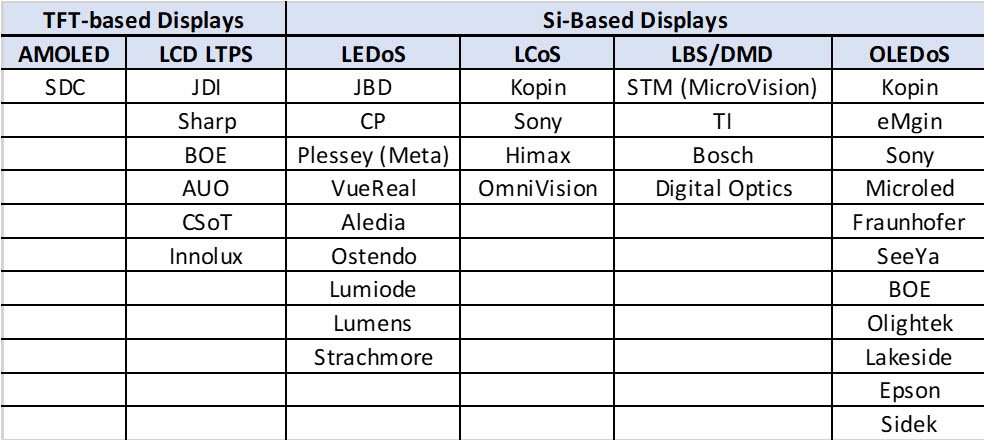 Table 1: VR/AR Display Panel Makers. Source: Omdia
Table 1: VR/AR Display Panel Makers. Source: Omdia
At the end of, 2021, Omdia estimated that there was $4.5 billion in OLEDoS investments in China, with BOE being the only established panel maker.
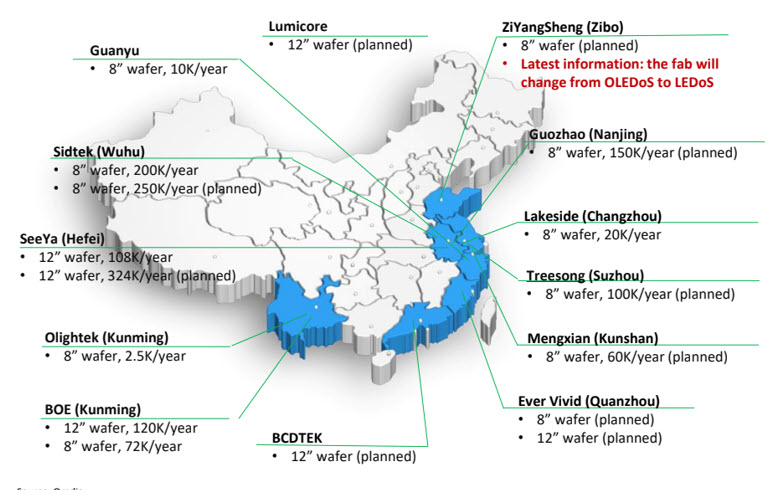 Figure 5: OLEDoS in China Source: China
Figure 5: OLEDoS in China Source: China
The supply of OLEDoS panels is about to change significantly as Apple has given its requirements for an MR device to Samsung and LG Display, which are now both in the planning process to build microOLED fabs, which could quickly obsolete the smaller players. eMagin is apparently trying to partner with Samsung to use eMagin’s patterning technology.
The next figure shows the difference between the performance of display technology for use in AR and VR. The MR (MX) application can effectively use microdisplays from either category.
 Figure 6: Display Module Comparison – AR vs. VR Source: Omdia
Figure 6: Display Module Comparison – AR vs. VR Source: Omdia
Fresnel lenses work the same as lighthouses in directing and enhancing an existing light source. Crudely put, current virtual reality HMDs are like having a lighthouse-beamed screen strapped to the face, requires significant space between the display and the Fresnel lens itself. Consequently, this bulks up the headset, adding weight and a large form factor.
Augmented reality strives for affordability and thinness, and is driven by iterations of the novel waveguide design. Future virtual reality HMDs will likely be driven by the Pancake lens technology. The pancake technology itself is nothing new. The military and scientific community used pancake optics years before virtual reality adopted it as early as a Pancake VR headset prototype in 2015 from eMargin, with Kopin, the leading developer of wearable headset components, following up with their iteration in 2017, called Kopin Elf.
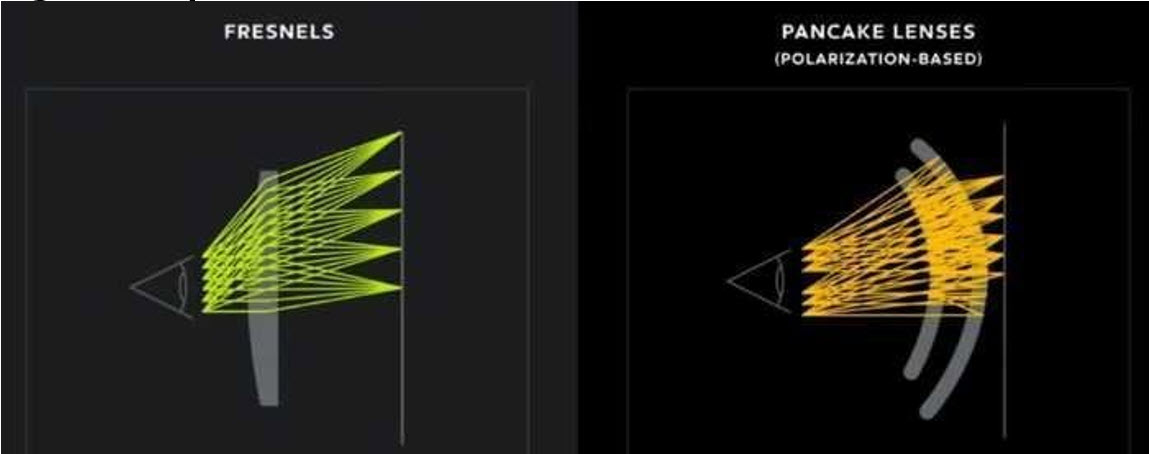 Figure 7: Optical Lens Performance. Source: VR Industry News
Figure 7: Optical Lens Performance. Source: VR Industry News
Essentially, pancake-enabled VR HMDs are pivoting the bulky perception of virtual reality to stylish fashion symbols with a thinner and lighter design, making virtual reality more accessible for early majority consumers. In effect, that is expanding the VR market to the benefit of everyone within the industry. Naturally, the bigger the market, the more advanced and innovative VR/AR becomes and better the industry gets. Kopin announced in mid-June 2021 an all-plastic pancake lens design called P95, “specifically optimized for use with a 2.6K x 2.6K OLED high-brightness microdisplays.
Comparing Fresnel and Pancake.
Pancake features more benefits than disadvantages compared to Fresnel, both in perceived image quality and the significantly slimmer and lighter form factor that Pancake enables. Performance depends on where the screen light is originating and the shape of the lens; the time it takes entering the lens versus exiting, as well as the wavelength (color) of the light itself.
- The Fresnel optics features a wide field of view compared to Pancake but is prone to chromatic aberrations (ghosting/overlapping colors).
- Software calibration taking up processing power must account for the Fresnel lens known as ‘pincushion distortion’. This distortion is similar to an image being stretched out in all four corners. The software then must artificially stretch the image further to normalize what is viewed by the wearer, all in real-time.
 Figure 8: Correcting Fresnel Distortion Source: VR Industry News
Figure 8: Correcting Fresnel Distortion Source: VR Industry News
Pancake Lenses work by folding many lenses together in a curve, bouncing light within the glass or plastic, in effect, slimming the distance needed between the wearer’s eyes and the display, making it thinner and lighter, while freeing up processing power, as there is no distortion problem for the pancake.
- The pancake design does not have the chromatic aberration present like the Fresnel.
- The downside to the pancake optics, compared to Fresnel, stems from pancake’s bouncing of light within the lens itself, resulting in low light efficiency. In short, it dims the perceived image for the wearer which is why the P95 pancake lens works well with ‘high-brightness micro displays’.
- The problem of ghosting is also a bane for the pancake lens.
The enabling technology behind this trend is the pancake lens design, by itself nothing new but revolutionary within VR HMDs. It will bring stylish designs that attract a wider audience and will be able to detach itself from external devices such as a capable laptop or smartphone.
2022 and beyond will be the time when virtual reality matures in both hardware and use cases, and the not-talked-about-enough technology, the pancake optical design, is the enabler of this.
The optics for a micro display includes the lens that is placed between the eye and the display. In order to keep the thickness of the device as low as possible, the lens is designed as thin as possible, but the thinner the lens the lower the luminance. The thinnest lens can reduce the luminance by 90%.
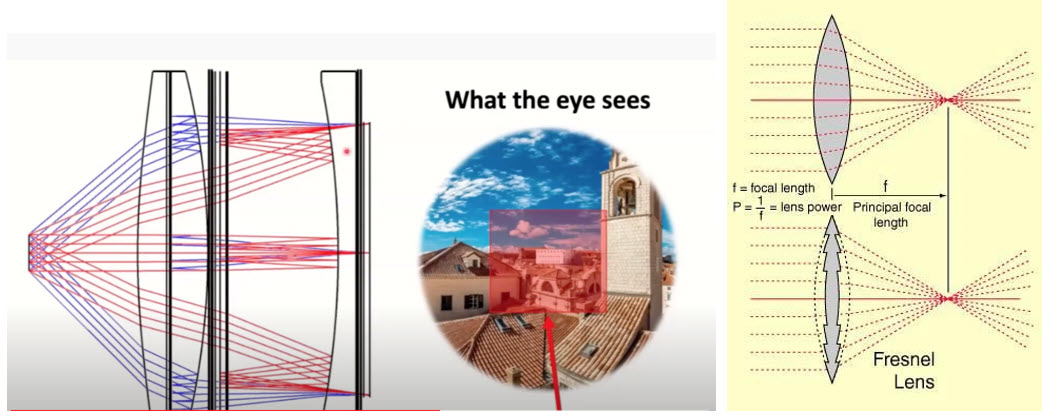 Figure 9: Optical Lenses. Source: Omdia/ OLED-A
Figure 9: Optical Lenses. Source: Omdia/ OLED-A
The next two charts show the various product planned thru 2023 and the display technology adoption.
 Figure 10: Trends in VR Display Technology Adoption Source: Omdia
Figure 10: Trends in VR Display Technology Adoption Source: Omdia
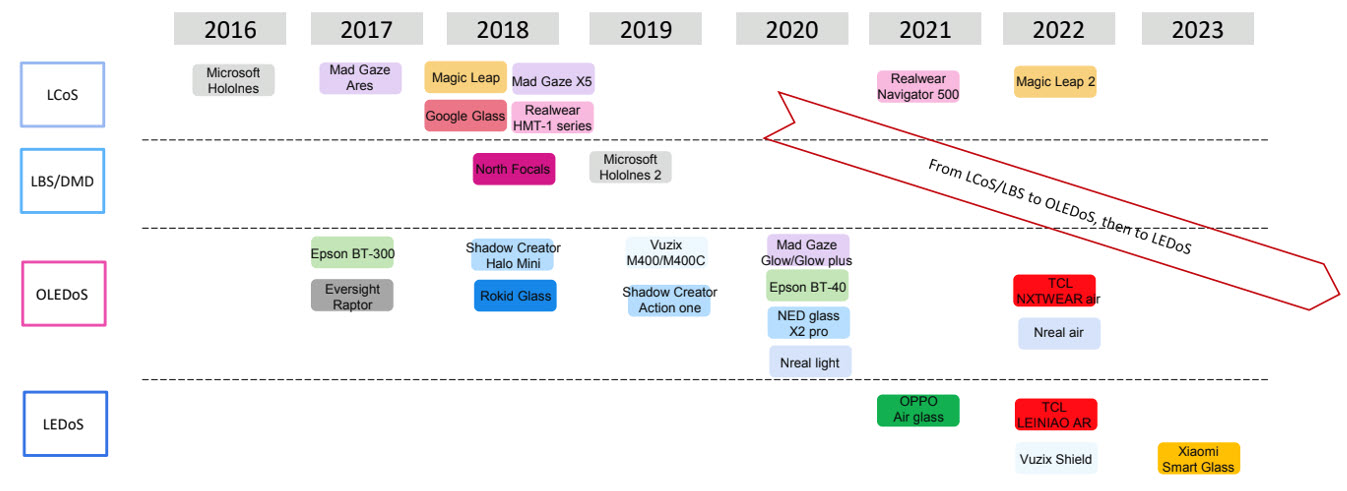 Figure 11: Trends in AR Display Adoption Source: Omdia
Figure 11: Trends in AR Display Adoption Source: Omdia
(BY)
(We ran Part 1 yesterday. The two parts will count as just one article if you have a free account).
Barry Young is the CEO of the OLED Association

